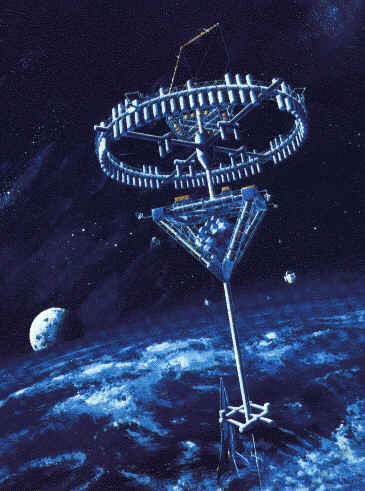Luckily it's easy to design basic accommodation in orbit - because it was already done in 1973(!) with the "Skylab" space station. Minimal living facilities require a cylindrical module with air-conditioning, some windows, and a kitchen and bathroom. But zero gravity allows you to build almost any shape and size, in almost any direction. So exploiting the full range of possibilities of zero gravity architecture will keep designers happy for decades! There'll also be rotating (and tethered) structures giving artificial gravity.
Getting Around
Lots of people who've been to space have described in detail what it's like to live in zero gravity. Of course, no-one has yet lived in a rotating space station like the "2001" space station. Such designs will probably be used, but building such a rotating structure will be a significant step beyond just attaching some modules together. It has the advantage of providing accommodation at different levels of artificial gravity, but with some important caveats as discussed by Dr.
Theodore Hall .
.
The key to moving in zero-G is to think of your center of mass - which is just behind your belly-button. Any time you push against someone or bump something, if the line of that push doesn't go through your belly-button, then it tends to set you rotating around your belly button! So to move in a certain direction you have to be sure to push in a line that goes through your belly-button (if you see what that means!)
At first, the key is just to move slowly and simply, so you have time to think what you're doing. But as you get the hang of it you'll find it enjoyable to push off from a wall with just the right rotation rate to land on your feet on the opposite wall. And then faster and faster! There are obviously all sorts of possibilities for dancing, gymnastics and zero G sports!
Luckily you don't need to sleep much living in zero gravity, so you'll have plenty of time for relaxing by hanging out (literally!) in a bar with a panoramic window looking down at the turning Earth below, or sitting in a darkened astronomical viewing room listening to a guide explain the sights you can see through the binoculars available, or discoing in zero G, or...
All Good Things...
Of course all good things have to come to an end, unfortunately! And so after a few days you'll find yourself heading back through the docking point to the returning vehicle - though you'll be much more expert at manoeuvring in zero G than you were when you arrived! You'll be thinking how soon you can save up enough to get back up again - or maybe you should change jobs to get to work in an orbiting hotel!



